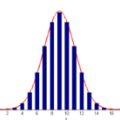Placing robots outside controlled conditions requires versatile movement representations that allow robots to learn new tasks and adapt them to environmental changes. The introduction of obstacles or the placement of additional robots in the workspace, the modification of the joint range due to faults or range-of-motion constraints are typical cases where the adaptation capabilities play a key role for safely performing the robot's task. Probabilistic movement primitives (ProMPs) have been proposed for representing adaptable movement skills, which are modelled as Gaussian distributions over trajectories. These are analytically tractable and can be learned from a small number of demonstrations. However, both the original ProMP formulation and the subsequent approaches only provide solutions to specific movement adaptation problems, e.g., obstacle avoidance, and a generic, unifying, probabilistic approach to adaptation is missing. In this paper we develop a generic probabilistic framework for adapting ProMPs. We unify previous adaptation techniques, for example, various types of obstacle avoidance, via-points, mutual avoidance, in one single framework and combine them to solve complex robotic problems. Additionally, we derive novel adaptation techniques such as temporally unbound via-points and mutual avoidance. We formulate adaptation as a constrained optimisation problem where we minimise the Kullback-Leibler divergence between the adapted distribution and the distribution of the original primitive while we constrain the probability mass associated with undesired trajectories to be low. We demonstrate our approach on several adaptation problems on simulated planar robot arms and 7-DOF Franka-Emika robots in a dual robot arm setting.
翻译:将机器人置于受控制的条件之外需要多功能的移动演示,使机器人能够学习新的任务,并适应环境变化。但引入障碍或将更多的机器人安置在工作空间,由于差错或情绪范围限制而修改联合范围,是适应能力在安全执行机器人任务方面发挥关键作用的典型情况。在本文中,我们为适应ProMP提出了一种通用的概率框架。我们统一了先前的适应技术,例如各种类型的障碍避免方法、通过轨迹、相互避免、在一个单一的框架中进行分析,并从少量演示中学习。然而,最初的ProMP的配制和随后的办法仅为具体的移动适应问题提供了解决办法,例如避免障碍,以及一种通用、统一、稳妥的适应方法。在本文中,我们为调整ProMP的工作制定了一种通用的概率框架。我们统一了先前的适应技术,例如,各种类型的障碍避免障碍,通过点、相互避免,在一个单一的框架中进行,并将它们结合到解决复杂的机器人问题。此外,我们从最初的ProMP 和随后的方法中,我们用新的调整技术来解决具体的运动适应问题,例如:避免障碍,通过不透路面的流流流的流分配;我们通过流的流的流的流的流分配,我们通过流的流的流的流的流的流的流的流的流的流的流的流的流的流的流的流的流的流的流的流的流的流的流的流的流的流的流。我们,我们用的流的流的流的流的流的流的流的流的流的流的流的流的流的流的流的流的流的流的流的流的流的流的流的流的流的流的流的流的流的流的流的流的流的流的流的流的流的流的流的流的流的流的流的流的流的流的流的流的流的流的流的流的流的流的流的流的流的流的流的流的流的流的流的流的流的流的流的流的流的流的流的流的流的流的流的流的流的流的流的流的流的流的流的流的流的流的流的流的流的流的流的流的流



